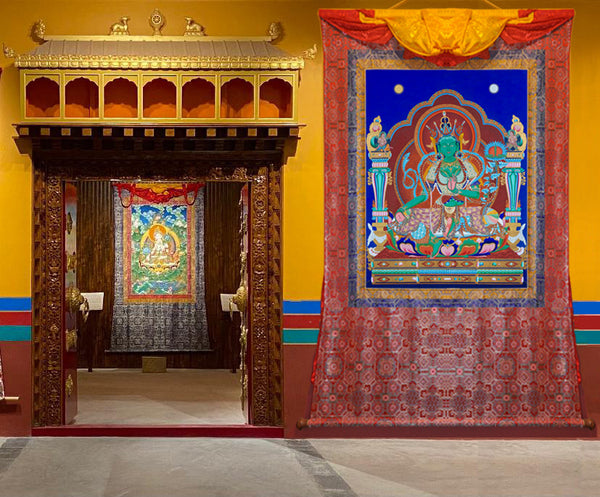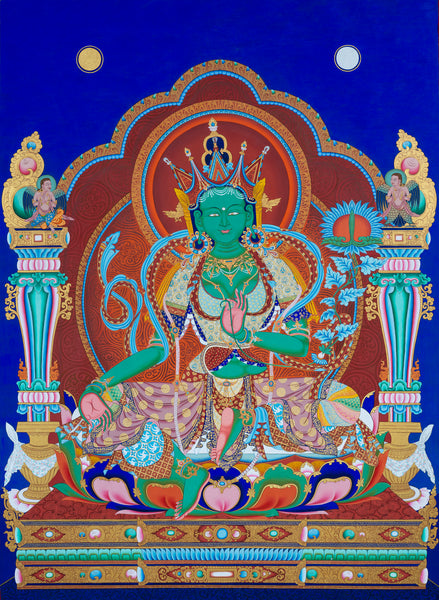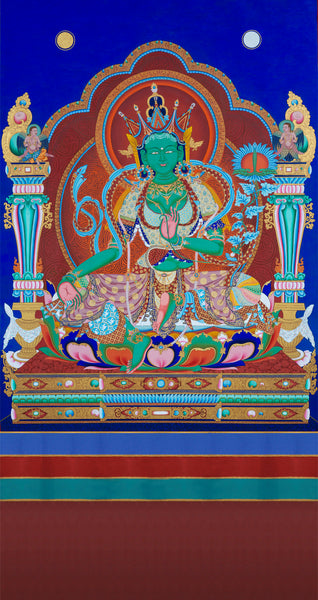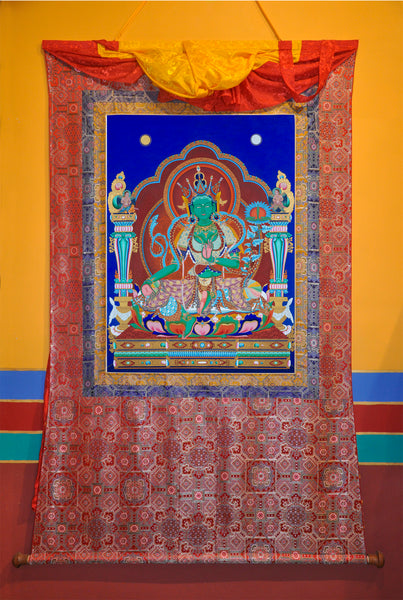4-5 Feet Tabo Tara (8-10 Feet with silk mount)
Image: Tabo Tara
Artist: Master Locho and Sarika Singh
1080 CE - 1350 CE
3 Years in Making ( 2017-2021)
This representations of the Green Tara is inspired by the paintings at the Tabo monastic complex in the Spiti Valley, often referred to as “Ajanta of the Himalayas”, located in the north-eastern part of the Indian state of Himachal Pradesh, wedged between the Great Himalayan Mountain and the Zanskar Mountain Ranges. Spiti has a very distinctive cultural and historical identity, defined by its incorporation and integration of other cultures into their own due to multiple circumstances of conquering. The Tabo monastery was strategically built upon the banks of the Spiti River drawing its strength, spiritual and physical, from the flowing waters. The monastery was built in 996 AD under the patronage of Yeshe-Ö, the first notable lama-king of the Guge Kingdom in the southwestern Tibetan Plateau, as part of his agenda to reaffirm the religiosity of the kingdom. This movement is now called the 'the second diffusion of Buddhism' as well as the 'Buddhist renaissance'. The monastery was spiritually conceived by Rinchen Zangpo, a progenitor and leader of this cultural and religious movement and a scholar and translator of Sanskrit Buddhist texts into Tibetan. Built over a thousand years ago, the Tabo monastery is one of the oldest surviving monasteries of the earliest period of Tibetan monastic art and culture.
The monastic complex was built in accordance of the concept of a mandala, in both its interior and exterior structure, which symbolizes unity, the perception of structured order, and ultimately an unification of cosmic principle. Tabo is comprised of eight temples, five of which are a part of the original structure. Among the original temples is the Serkhang, the golden temple, which is astutely named as it is said that a layer of gold-dust as thick as a yak's skin coated the inner surface of these walls. On the right wall of this temple, the central figure is the Green Tara in varada-mudra, a hand position that signifies offering, generosity and compassion.
Among the identifying attributes of this representation of Tara is her exaggerated hourglass figure, enhancing the width of her bosom as revealed by her dress. This depiction of the Green Tara reminds the viewer of her softer attributes, the compassion, kindness and affection embodied in her exaggerated feminine form and signified by the varada-mudra.
In one hand she holds a closed lotus bud, which represents purity in a time before enlightenment, and with the other, she holds a blossoming lotus, which marks the spiritual ascension of enlightenment. The Green Tara has committed herself to reincarnation until all of humanity has been guided through the path towards nirvana, the two lotus flowers illustrate her dedication to this mission, as she will carry humanity through the process as she carries the lotuses. Additionally, her feet are positioned with one foot out, ready to step out into a worldly existence, ready to intervene as our protector, ready to help as our savior.
The monastery was built upon flat ground, as opposed to into a hilltop or mountain range, due to the sources of capital raised for its construction. Built in a time before great financial support for monastic spaces, the capital was raised from local sponsors and patrons, so it had to be built in a space accessible to these donors. Furthermore the valley site conveys the early Buddhist philosophy emphasizing the ideal that enlightenment was attainable even to lay people. This image of the Green Tara further emphasizes these sentiments as she is portrayed as giving and guiding, ready to step in on behalf of the community.
The name “Spiti” means “the middle land”, in reference to its location as the land between Tibet and India. In addition to its geographical placement, Spiti and specifically the Tabo monastery has been a middle ground in a cultural sense, a place for the integration of Indian and Tibetan culture and tradition. It was at Tabo that Tibetan monks and Indian pandits studied together, side by side, and translated Buddhist scripture from Sanskrit into Tibetan. The murals reflect in their Kashmiri tendencies, features from Nepali and Chinese traditions, and influences from the Sakya-pa style of Central Tibet, the blending of culture. In the paintings red always dominates the foreground, structured by ornamental lining in darker red and counterbalanced by glowing blue, green, and yellow.
The research and drawing of this painting were conducting by Sarika Singh, a process that took three months. The painting was executed by Master Locho, Sarika Singh and Geetenjali Behera. The minerals used to create the colors of this painting are azurite blue, ultramarine blue, malachite green, cinnabar vermillion red, orpiment yellow, and calcium carbonate white chalk. In addition to these minerals, pure gold and silver are used as accent colors. These mineral pigments are mixed with glue and water to create different colored paints. As evidenced by the preservation of Buddhist paintings from a thousand years ago, using this traditional process ensures the longevity of the painting.
This painting took three years to complete.








